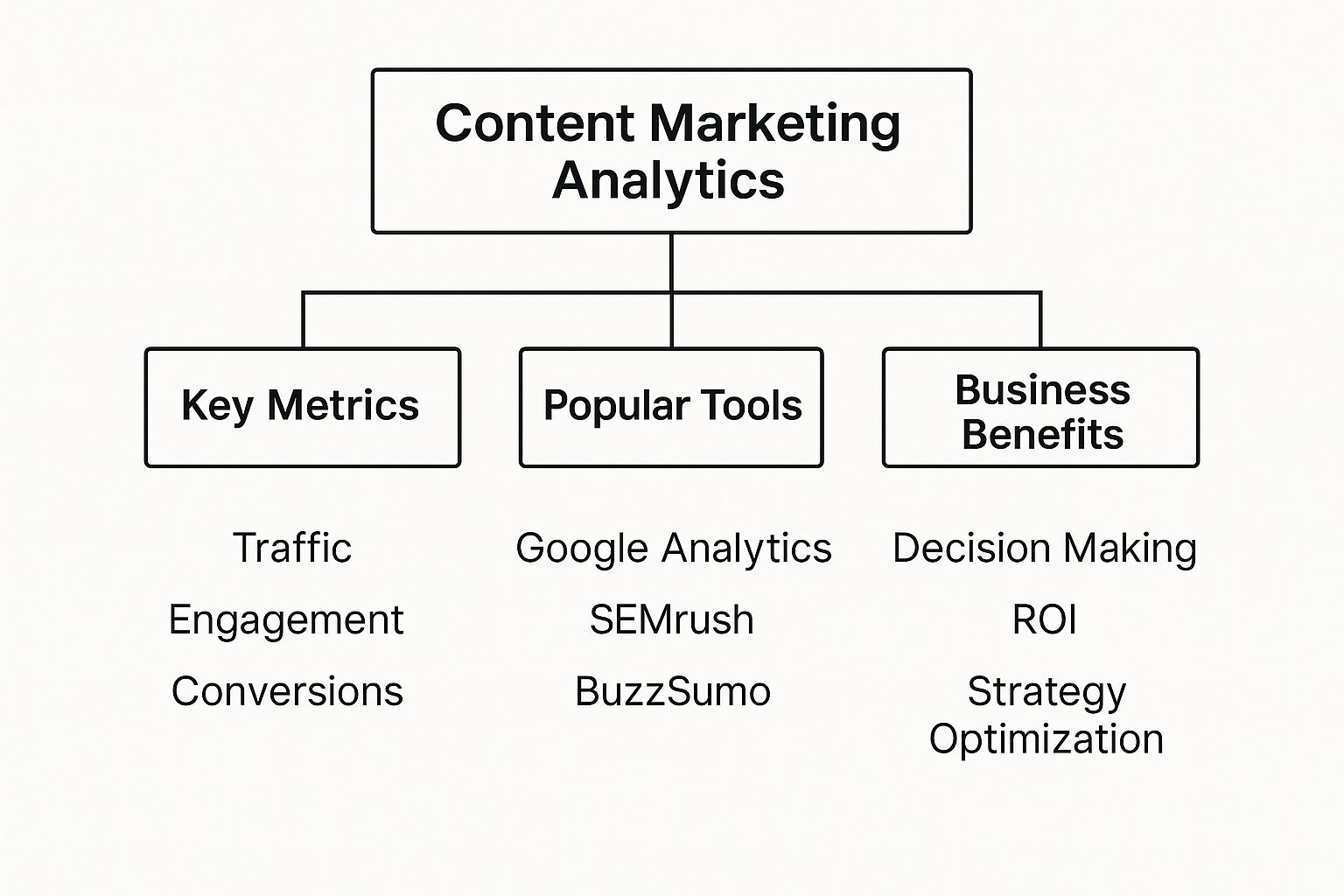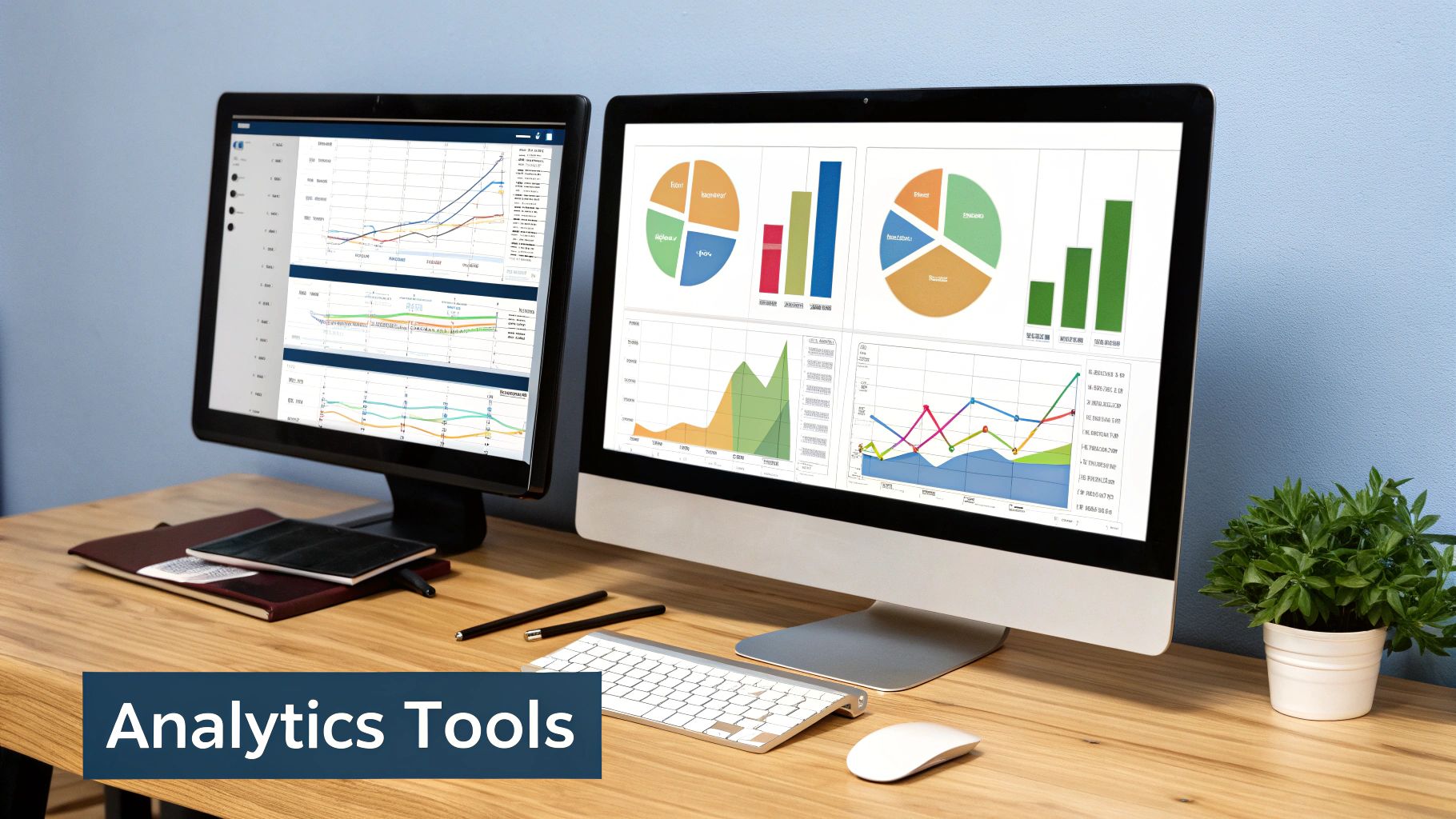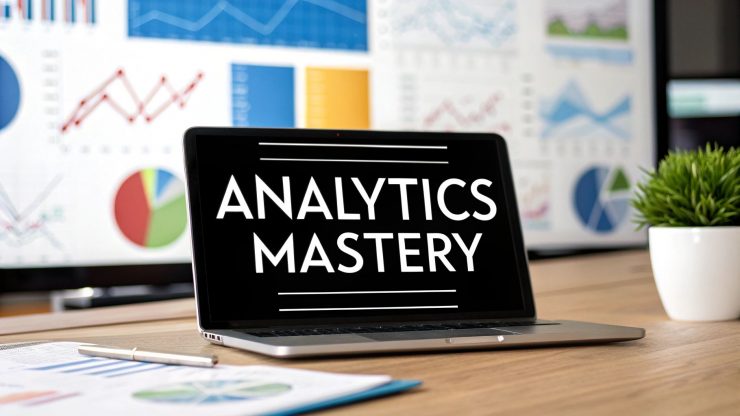So, what exactly is content marketing analytics?Think of it less as a stuffy, academic discipline and more like a GPS for your entire digital strategy. It’s the system that tells you what’s hitting the mark, what’s falling flat, and how to make smart decisions that actually move the needle for your business.
Why Content Marketing Analytics Matters
Here's a hard truth: creating content without measuring it is like driving blindfolded. You're definitely moving, but you have no clue if you're even on the right road, let alone heading toward your destination. Analytics provides the map and the compass, turning your creative hunches into a reliable system for growth. It’s the bridge between your hard work and real, tangible business results.
This isn't just about counting vanity metrics like page views. It's about getting inside your audience's head and understanding their entire journey—from the moment they first find your content to the final action they take. That’s the kind of insight that lets you fine-tune your strategy, prove your value, and turn content from a simple expense into a powerful, revenue-generating asset.
From Blind Guesses to Smart Decisions
Without analytics, every blog post, video, or social media update is essentially a shot in the dark. You hope for the best, but you don't really know.
With a solid analytics practice, you can finally answer the questions that matter:
- What topics are my readers actually interested in?
- Which content formats—like guides, case studies, or infographics—are bringing in the most qualified leads?
- Are my distribution channels pulling their weight and delivering quality traffic?
- Where are people getting stuck or leaving in the buyer's journey?
Knowing the answers helps you put your time, energy, and budget where they’ll have the biggest impact. If you want to see this in action on a specific platform, diving into a complete guide to Instagram analytics for business is a great way to understand how tracking performance can fuel growth.
"Data is the voice of your customer. Content marketing analytics is how you learn to listen."
To help you get started, we can break down the whole field into four fundamental pillars. Think of these as the foundation of your measurement strategy.
The Four Pillars of Content Marketing Analytics
This table summarizes the core components of content analytics, their purpose, and the key business questions they help answer.
| Pillar | What It Measures | Key Question It Answers |
|---|---|---|
| Consumption Metrics | How many people are viewing, reading, or watching your content. | "Is anyone seeing our stuff?" |
| Engagement Metrics | How people are interacting with your content (likes, shares, comments, time on page). | "Do people actually like what they see?" |
| Conversion Metrics | How many people take a desired action (like signing up for a newsletter or downloading an ebook). | "Is our content driving action?" |
| Business Impact Metrics | How content contributes to bottom-line results (leads generated, sales influenced, customer retention). | "Is our content making us money?" |
By focusing on these four areas, you can build a complete picture of your content’s performance, from initial discovery all the way to its impact on revenue.

Proving Your Content's ROI
Ultimately, the most critical reason to embrace content marketing analytics is to prove its return on investment (ROI). It's no secret that content marketing has become a go-to strategy; a massive 82% of companies are expected to use it by 2025.
But here’s the kicker: the marketers who actually measure their work are the ones seeing the best results. In fact, 76% of them confirm that their content generates valuable leads for their business. By directly connecting your content's performance to core business goals like leads, sales, and customer loyalty, you can finally justify your budget and show everyone exactly how your team contributes to the bottom line.
Tracking the Metrics That Actually Matter

Jumping into content marketing analytics can feel overwhelming, like trying to drink from a firehose. There are countless data points you could track, but most of them are just noise. The real trick is knowing which numbers actually signal success and tie back to your business goals.
Think of it like flying a plane. A pilot isn't staring at every single dial at once. Instead, they focus on the critical instruments—altitude, airspeed, and fuel level—to understand if they're on course. We can approach our content metrics in the same way, grouping them into a few key categories that tell us what we need to know.
Consumption and Engagement Metrics
First things first: is anyone actually seeing your content? And if they are, do they care? These initial metrics are your first clue as to whether your message is hitting home with the right crowd.
- Pageviews and Unique Visitors: These are your baseline numbers, showing the raw size of your audience. Big numbers are a great start, but they only tell part of the story.
- Average Time on Page: This is where the truth comes out. Are people actually reading that long-form guide or just glancing at it? A low time on page is a major red flag.
- Bounce Rate: This tells you the percentage of visitors who land on your page and leave without clicking anywhere else. A high bounce rate often means your headline made a promise your content couldn't keep.
- Social Shares and Comments: When someone shares your work, they're giving it a public vote of confidence. This is a powerful, direct sign that your content resonates.
High traffic paired with a high bounce rate is a classic warning sign. It screams "content-audience mismatch." On the flip side, strong engagement proves your message is connecting and building a real relationship.
This is especially true on social media, which is deeply intertwined with content marketing. An estimated 5.42 billion people are on social platforms, and businesses are expected to spend a whopping $276.7 billion on social ads to reach them. Getting your content engagement right on these platforms is absolutely critical.
Conversion and Retention Metrics
Eyeballs and shares are great, but they don't pay the bills. This is where we measure how well your content inspires people to take profitable action and encourages them to stick around for the long haul.
- Conversion Rate: This is the ultimate test. What percentage of users took the action you wanted them to, like signing up for a newsletter or downloading an ebook? This is a direct measure of your content's persuasive power.
- Click-Through Rate (CTR): This focuses on the calls-to-action (CTAs) within your content. A healthy CTR shows that your offer is compelling and you've placed it in the right spot.
- Leads Generated: How many potential customers can you trace back to a specific blog post or video? This metric draws a straight line from your content to your sales pipeline.
- Return Visitors: Are people coming back for more? A high number of return visitors is a fantastic sign that you're building a loyal audience and becoming their go-to resource.
Knowing which metrics to focus on is a foundational skill. As strategies and platforms change, so do the data points that matter most. It's always a good idea to stay on top of emerging content marketing trends to keep your analysis sharp. For an even closer look at what to track, you can explore the content marketing metrics that truly matter for driving real growth.
How to Find the Story in Your Data

Collecting data is just the beginning. The real magic in content marketing analytics happens when you start interpreting those numbers. Let's be honest, a dashboard full of raw data is just noise until you connect the dots and turn it into a story about what your audience is actually doing. The goal is to get past what happened and truly understand why it happened.
Think of yourself as a detective. Every metric is a clue, and your job is to piece them together to crack the case: Is my content actually working? This means you can't just look at Google Analytics, your SEO platform, and social media insights in their own little silos. You have to see them as interconnected parts of a bigger picture.
Let's say you just launched a big, in-depth guide on your blog. The initial traffic numbers look great. Awesome! But that's just chapter one. To get the full story, you need to dig a lot deeper.
Connecting the Dots: A Practical Walkthrough
Let’s walk through how you’d analyze that new blog post by asking a series of connected questions. This is how you turn a spreadsheet of data into a clear, actionable narrative.
1. How Did They Find Us? (Acquisition)
First things first, head over to your traffic acquisition report in Google Analytics. Don't just glance at the total number of visitors. The real insight is in the details, so segment that data by channel. Did most people arrive from an organic search, a targeted social media campaign, or your latest email newsletter?
This step immediately tells you which of your distribution channels are pulling their weight. If you notice a huge wave of traffic from LinkedIn but only a trickle from X (formerly Twitter), that’s a powerful clue about where your audience for this specific topic hangs out online.
2. What Did They Do Next? (Behavior)
Okay, so you know how they got there. Now, what did they do once they landed on the page? This is where you look at on-page behavior metrics for that specific post.
Check the average engagement time. A high number is a great sign; it means people are actually sticking around to read your in-depth guide. But if you have high traffic and a low engagement time, you've got a disconnect. Maybe the headline was misleading, or the intro didn't hook them.
Next, look at scroll depth. Did most visitors even make it past the fold? If you're using a tool like EvergreenFeed to schedule your social promotions, you can cross-reference social engagement spikes with on-site behavior. This helps you see if the snippets you’re sharing on social media are attracting genuinely interested readers or just drive-by clickers.
The most revealing stories are found in the gaps between metrics. High traffic from social media but low time on page means your promotion is good, but your content isn't delivering on the promise.
3. Did It Accomplish Our Goal? (Conversion)
Finally, it all comes down to this: did the content move someone to take action? This is where you connect their visit to a business goal. Did readers of your guide click an internal link to a related product page? Did they sign up for the free template you offered halfway through the article?
Tracking these goal completions is the final chapter of your story.
By following this three-act structure—Acquisition, Behavior, and Conversion—you get the full picture. You might find that while organic search brings in fewer visitors overall, those visitors are twice as likely to download your ebook. Now that's a story you can act on. The next logical step would be to double down on your SEO efforts for that post. This is the real power of finding the narrative in your content marketing analytics.
Turning Analytics into Actionable Strategy

Collecting data is just the first step. The real magic happens when you use those numbers to make smarter decisions. After all, insight without action is just trivia. This is where you connect the dots between interesting stats and a growth-driving strategy, creating practical optimization loops you can put to work right away.
A great place to begin is with a content audit. Don't think of this as judging your past work. It's really a systematic review to find hidden opportunities. By digging into your performance metrics, you can quickly identify your star performers, find posts that just need a quick update to shine again, and spot the "zombie pages"—content that gets almost no traffic and might even be weighing down your SEO.
Think about it: reviving a high-potential but slightly outdated post is often way faster than building a new one from the ground up. At the same time, pruning or redirecting that zombie content can clean up your site and give your overall authority a nice boost.
Finding Opportunities in Your Data
Beyond tidying up old posts, your analytics are a treasure map for what to create next. This is how you shift from making reactive fixes to building a proactive strategy. One of the best ways to do this is with a content gap analysis.
Take a look at the search queries report in Google Search Console. You'll likely find keywords your site ranks for, but where you aren't quite hitting the mark on what the user actually wants. These are your content gaps—topics your audience is literally telling you they want to know more about.
Analytics doesn't just tell you what you've done; it shows you what your audience wants you to do next. It’s a direct line to their needs and interests.
For example, maybe your guide on social media scheduling tools is getting traffic from people searching for the "best time to post on Instagram." If you don't answer that question directly in the article, you've just uncovered a perfect opportunity. Creating a new, dedicated post on that exact topic is a decision backed by data, not just a gut feeling. To take this even further, you can see how this applies directly to your social channels in our guide on social media marketing analytics.
Testing and Optimizing for Conversion
Finally, putting your analytics into action means you have to start experimenting. You don’t need to blow up your entire strategy. Small, controlled tests can often lead to the biggest wins.
This is where A/B testing is your best friend. Here are a few simple but powerful things you can test:
- Headlines: Write two different headlines for a blog post. See which one gets more clicks when you share it in your newsletter or on social media.
- Calls-to-Action (CTAs): Experiment with different button text, colors, or even placement. Does "Get the Guide" work better than "Download Now"? Let the data decide.
- Content Formats: Pit a written guide against a video tutorial on the same subject. You might be surprised which one keeps your audience engaged longer.
A tool like EvergreenFeed can help you easily test different social media posts that all point to the same content, letting you quickly find the hook that resonates most. This cycle of continuous improvement—Audit, Analyze, and Test—ensures every bit of data you gather makes your content strategy smarter and more effective over time.
The Future of Analytics with AI
For years, content analytics has been like driving while looking in the rearview mirror—it tells you exactly where you've been. But what if you had a navigation system for the road ahead? That's what AI brings to the table. It's shifting content marketing analytics from a historical record to a powerful predictive tool.
This isn't about robots taking over. Think of AI as your expert co-pilot. It processes immense amounts of data, spotting tiny patterns and correlations that a human could never hope to see. It’s turning analytics into a system that doesn’t just describe results but can also predict outcomes and prescribe the best actions to take.
The numbers back this up. The global content marketing world is set to become a $2 trillion industry by 2032, with AI being a huge part of that growth. Already, about 90% of content marketers are planning to fold AI into their work by 2025, largely because those who use it report far fewer pieces of underperforming content.
From Manual Tasks to Automated Insights
So, what does this actually look like day-to-day? It means less time spent on tedious manual work and more time for genuine strategy. AI is already making a huge difference in a few key areas.
Take automated topic ideation. Instead of spending hours digging through keyword tools, an AI can scan competitor articles, search engine trends, and social media chatter to surface topics with a real shot at ranking and engaging your audience.
Then there’s sentiment analysis at scale. AI can read through thousands of comments and social media mentions in seconds, giving you an instant, accurate read on how people feel about your brand. You can learn more about these powerful AI applications in digital marketing to see how they're reshaping workflows.
AI doesn't replace the marketer; it empowers them. It handles the heavy lifting of data analysis, freeing up strategists to focus on creativity, narrative, and building genuine customer relationships.
The table below shows just how much things are changing. We're moving away from slow, manual processes toward intelligent, automated systems that work for you.
AI in Analytics: Before and After
| Analytics Task | Traditional Approach (Manual) | AI-Powered Approach (Automated & Predictive) |
|---|---|---|
| Topic Ideation | Hours of keyword research and competitor analysis. | Instantly generates topic ideas based on real-time trends and audience data. |
| Content Performance | Reviewing historical data to see what worked in the past. | Forecasts which content formats will perform best with specific audiences. |
| Audience Sentiment | Manually reading comments and social media mentions. | Analyzes thousands of data points to gauge overall audience feeling in real-time. |
| A/B Testing | Setting up and manually monitoring a few headline or CTA variations. | Runs thousands of micro-tests automatically to continuously optimize content. |
| Personalization | Grouping audiences into broad segments based on demographics. | Delivers unique content and recommendations to each individual user. |
This isn't just about making things faster; it's about making them smarter. AI allows us to operate on a level that was simply out of reach before.
Hyper-Personalization and Predictive Optimization
The most exciting part of all this is hyper-personalized content delivery. AI can analyze an individual's behavior to show them the perfect blog post, product, or call to action at the exact right moment. This is a huge leap from basic audience segmentation into true one-to-one marketing.
Here's how AI is changing the game:
- Predictive Analytics: AI models can tell you which articles are likely to be hits with certain customer groups before you even publish them.
- Automated A/B Testing: Imagine an AI running countless tiny tests on your headlines and images to constantly improve click-through rates, all on its own. A platform like EvergreenFeed could use this to learn which post variations work best for different followers and automatically feature them.
- Intelligent Content Recommendations: Those "you might also like" sections on your blog can become incredibly accurate, powered by an AI that truly understands what each visitor wants to see next.
In the end, bringing AI into your analytics isn't just a nice-to-have feature. It’s quickly becoming a fundamental part of building a competitive and effective content strategy.
Frequently Asked Questions
Alright, we've covered a lot of ground. But knowing the theory is one thing; putting it into practice is another. It's totally normal for new questions to come up once you start digging into your own data.
Think of this section as a quick reference guide. I've gathered some of the most common questions that pop up when people first get started with content marketing analytics. The goal is to clear up any lingering confusion and give you the confidence to start making smarter decisions right away.
What Metrics Matter Most for Content Marketing?
This is the big one, isn't it? While the best metrics are always tied to your specific goals, you can't go wrong by starting with a core set that tells a complete story. Don't get bogged down tracking dozens of data points; focus on the essentials.
Here are the heavy hitters I always recommend keeping an eye on:
- Average Engagement Time: Are people actually sticking around to read or watch? This is a huge clue about your content's quality and relevance.
- Conversion Rate: This is where the rubber meets the road. Is your content compelling people to take the next step, whether that's signing up for a newsletter or buying a product?
- Return Visitor Rate: This is your loyalty metric. It tells you if you're building a real audience that trusts you enough to come back for more.
- Search Rankings: Tracking your position for key search terms shows whether you're winning the long game of attracting valuable organic traffic.
Start with these four. Together, they give you a balanced picture of engagement, direct action, audience loyalty, and long-term visibility.
How Often Should I Check My Content Analytics?
It's tempting to refresh your analytics dashboard every five minutes, but that’s a recipe for anxiety. The key is consistency, not constant surveillance. A tiered schedule is a much healthier and more effective approach.
I find a blended rhythm works best: glance at high-level traffic daily or weekly, dive deeper into content performance monthly, and conduct a full strategic review each quarter. This keeps you responsive to real trends without getting distracted by normal, everyday noise.
This way, your decisions are based on meaningful patterns, not just a random spike or dip on a Tuesday afternoon.
What Should I Do with Underperforming Content?
First off, don't just hit the delete button! Finding a post that isn't hitting its marks isn't a failure—it's an opportunity. The hard work of creating it is already done, which means you have a chance for a quick win.
Before you give up on a piece, try one of these revival tactics:
- Rewrite and Refresh: The world changes. Update your post with fresh information, newer statistics, or more current examples to bring it back to life.
- Optimize for SEO: What people are searching for also changes. Use an SEO tool to find new keywords and opportunities, then rework your title, headings, and body copy to match.
- Enhance the Format: Is the post a giant wall of text? Break it up. Add bullet points, shorter paragraphs, compelling images, or even a short video to make it easier and more enjoyable to consume.
A few smart tweaks can often turn a "zombie page" into one of your best performers. This is what turning analytics into action really looks like.
Ready to stop guessing and start growing? EvergreenFeed automates your social media scheduling, so you can focus on creating great content while ensuring it gets the consistent promotion it deserves. Stop wasting hours on manual posting and start building a powerful, automated content machine today. Sign up for your free EvergreenFeed account and see the difference.




